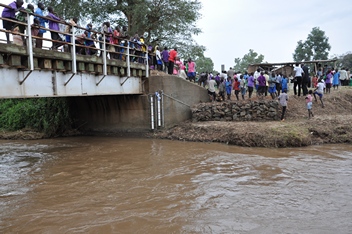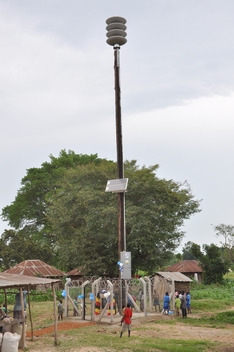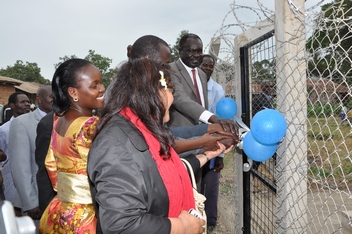It was just after midnight when Simon* was woken up by a loud blaring noise tearing into the dark night. It had been raining heavily over the past few days and Simon thought a lorry was stuck on the muddy main road.
He tried to ignore the noise, but it got louder with each passing second. He stepped out of his bed. Even before his feet could reach the floor he felt wetness. He stood up, the water was ankle high.
It was at that moment that he realized the noise outside was not a lorry but the newly installed flood warning system.
 "Wake up, wake up," he shouted to his wife. "The flood is approaching we must leave the house now. Get the children out of the house now" he said, wading through the water to reach the door.
"Wake up, wake up," he shouted to his wife. "The flood is approaching we must leave the house now. Get the children out of the house now" he said, wading through the water to reach the door.
"We must try and reach the hill on the other side of the road. It is high ground and the flood water does not reach there," he told his family.
By the time Simon and his family got to the main road the water was already knee high.
Safe on high ground, the villagers huddled in small groups to discuss their night ordeal.
"That siren they have installed by the river has saved the lives of our families. It is very loud, but I don't mind as long as it will help save lives in our village. After all, some of us are deep sleepers," said Simon as his fellow villages nodded in approval.
For many years Butaleja District in Eastern Uganda has been ravaged by flood waters from the River Manafwa.
Residents have watched helplessly as the water destroyed their farmlands, washed away their houses and other properties.
To help address the situation, the Government of Uganda, with the support of the International Telecommunication Union (ITU), installed solar powered Flood Early Warning Systems to warn residents of raising water levels.
The first flood warning system was installed on 22 September 2014, on the Namulo Bridge in Butaleja District.
 The warning system comprises three main components:
The warning system comprises three main components:
A sensor that is placed in the river;
A solar-powered siren adjacent to the river and,
A solar powered Control Centre at the District headquarters with backup computers to monitor the performance of the sensors and siren system.
Once the water levels reach a certain threshold on the sensor, the siren is automatically activated. The blaring sound can be heard over a 10 mile radius. Staff at the control center also use the siren system to broadcast messages in English and Lunyole, the local language, to guide residents to safely evacuate.
"Our partnership with the Government of Uganda reinforces ITU's commitment to increase the use of telecommunications and ICTs to enhance climate change adaptation and mitigation, and disaster management," said Mr Brahima Sanou, Director of the ITU's Telecommunication Development Bureau.
"The commissioning of this project comes at the right time when the international community is taking stock of the implementation of the Hyogo Framework adopted in 2005 during the World Conference on Disaster Risk Reduction (WCDRR), and preparing for the next
WCDRR to be held in March 2015, in Sendai, Japan," he added.
Hon. John Nasasira, Minister of Information and Communication Technology, thanked the International Telecommunication Union for its commitment and assistance to reduce the impact of natural disasters in the country. "This early warning system is a welcome relief for the people of Butaleja District who have for years lost lives and property because there was no flood warning," he said.
"This is a step in the right direction as projects of this nature save many lives," said Mr Cosmas Zavazava, Chief of the Department of Project Support and Knowledge Management at ITU. "This is the first time ITU has co-financed an alerting system with a government in Africa. A second flood warning system was installed in Butaleja District on 5 January 2015. Similar work has already been done in Asia and we are looking forward to supporting other countries across the globe in deploying ICTs for disaster preparedness and response financed through solid partnerships forged with governments, local communities and the private sector."
Representing ITU at the ceremony was Mrs Fuatai Purcell, the Head of ITU's Division of Least Developed Countries, Small Island Developing States, Landlocked Developing Countries, Emergency Telecommunications and Climate Change Adaptation.
 "Natural disasters are on the rise. Modern technologies when appropriately deployed can significantly reduce loss of life, injuries and destruction to property," said Mrs Purcell.
"Natural disasters are on the rise. Modern technologies when appropriately deployed can significantly reduce loss of life, injuries and destruction to property," said Mrs Purcell.
Mr Godfrey Mutabazi, Director of the Uganda Communications Commission, described the installation of the system as a new dawn for the population around Butaleja District and the larger Mt Elgon region.
"This project is in line with Uganda's National Vision 2040 which identifies ICTs among key foundations to spur Uganda's transformation into a modern and prosperous economy," he said.
At day break, Simon and his fellow villagers had a first-hand look at the disaster they all managed to escape from. Some houses were still deep in flood waters. It will be a few days before they can go back to their homes and rebuild their lives.
"Thanks to the newly installed flood warning system, my family and I feel much safer," Simon whispered into the ear of his 10-month-old baby.
 UGANDA_ITU_more_pictures_of_the_launch.pdf
UGANDA_ITU_more_pictures_of_the_launch.pdf
The ITU Telecommunication Development Sector considers emergency telecommunications an integral part of development agenda in the post-2015 period and is working hard to ensure a natural link between ICTs for development and ICTs for disaster management. 
Emergency telecommunications is vital for disaster prediction, detection, alerting and response. In the immediate aftermath of disasters, ICTs ensure timely flow of vital information that is needed by government agencies and humanitarian actors responding to the disaster. ICTs are also crucial in coordinating logistics such delivery of medicines, food, and shelter to the affected population.
ITU-D Study Group question 5/2 deals with the utilization of telecommunications/ICTs for disaster preparedness, mitigation and response.
"Telecommunications/ICTs play a critical role in disaster risk reduction, prediction, preparedness, mitigation and response. It is important for member states to develop telecommunication/ICT disaster preparedness plans and strategies, taking into account of the need for resilient redundant infrastructure and systems."
Dubai Declaration, adopted at WTDC-14
This year marks the 150th anniversary of the International Telecommunication Union. For a century and a half since 1865, ITU has been at the center of advances in communications – from telegraphy through to the modern world of satellites, mobile phones and the Internet. The theme of ITU’s 150th anniversary is “Telecommunications and ICTs: drivers of innovation”. Throughout 2015, ITU will organize several events highlighting ICTs as the drivers of innovation and sustainable development both at ITU headquarters in Geneva and around the world. For more information, click
here.
Simon* Not his real name
